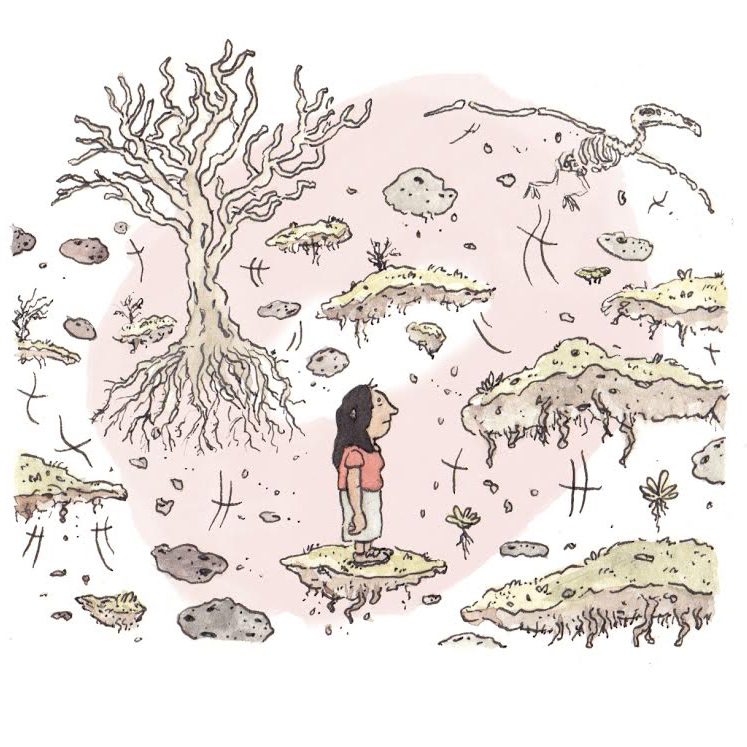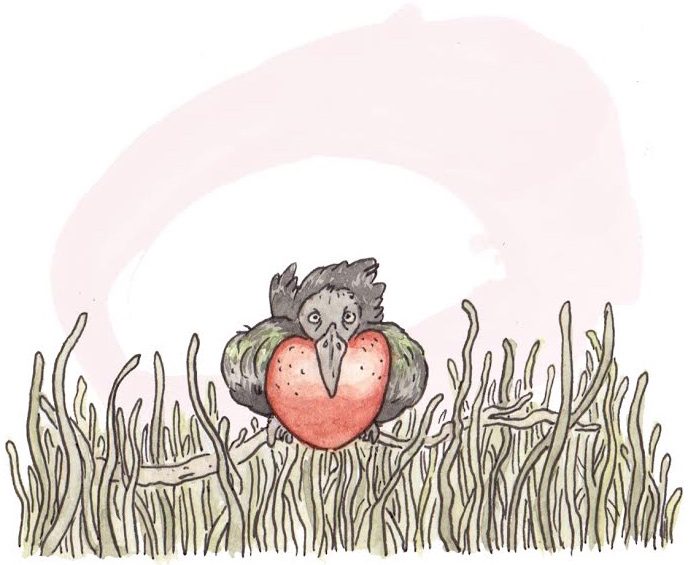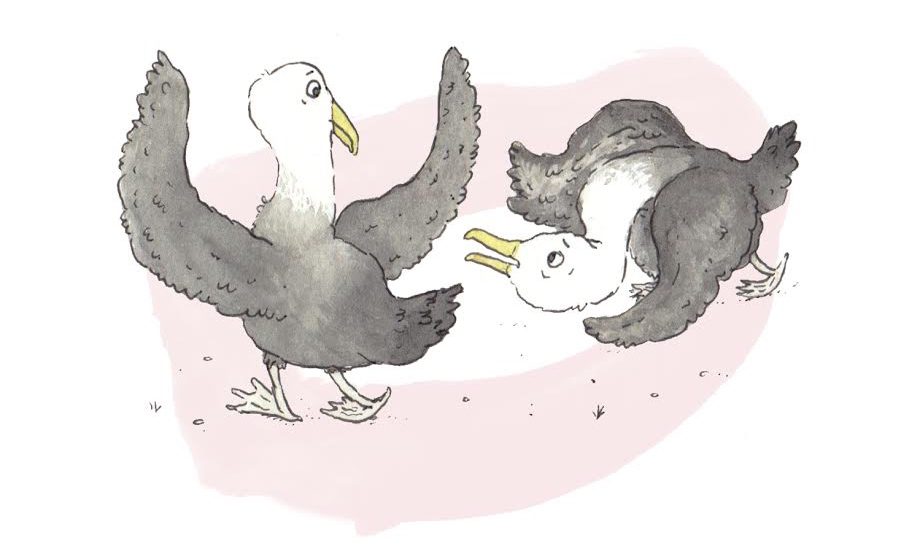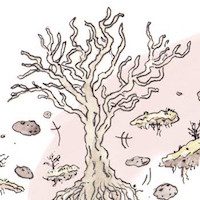Two waved albatrosses dip and bend before clicking long gold beaks together, one-two-three-four-five. Already short birds, when their faces near the ground, their beaks, barely hooked at the tip, remain parallel to it. Although their slender necks are white as ice, a careful painter would have to shade in the tiny “waves” of grey and brown at the base of their necks where their plumage shades to the color of butter before darkening to charcoal. Their flattened heads make them look whittled out of wood like marionettes, rather than made of feathers.
The pair taps back and forth in rapid succession, before one pulls away to point his or her beak at the sky or open his beak wide. After they duel, they dip again, walking around each other honking, as they bob their heads from side to side and strut. Courtship for waved albatrosses looks like a duel, but it leads to love, a charming illustration of the idea that mimicry is a way of empathizing.
Breathtakingly graceful when working the wind, an albatross’s expressions of love are more comic than grand. With wingspans of seven or eight feet, the body of the waved albatross is surprisingly compact, weighing no more than eleven pounds. They waddle on large grey webbed feet like large geese, wings tucked behind them, and it’s only after they bumble down their invisible runway and they finally lift off the ground, their wings lifted by wind, that you realize their magnificence.
*
The summer after an abortion I regretted, I fell into a half-hearted depression. I was embarrassed and ashamed. I knew intellectually that I shouldn’t feel bad—that getting an abortion was a relatively commonplace act, and not one that any woman should be ashamed of choosing. And yet, although I had several dozen female friends at the time, only one of them had told me of her abortion. She had not suffered from it, and somehow knowing that my friend had known immediately it was the right decision, and was relieved to get it out of the way, I felt worse. I couldn’t feel that certain about anything—about my troubled boyfriend, about the fetus, about my legal career. I was filled with doubt, and if I was going to feel certain about anything, my tendency was to feel certain everything was going to shit.
I had grown up in a left-wing Indian immigrant household. While my family was feminist when it came to employment, social activity and friendship, it was conservative when it came to sex, making my decision particularly fraught. I was twenty-seven at the time, and I kept wondering if this would come back to haunt me: the decision not to have a child just because I didn’t want to be a single mother. My boyfriend of the time was dismayed by my doubt and instead of letting me make my own decision, strongly pressured me into going against my feelings and getting the abortion. He didn’t plan to stick around if I had the baby. He didn’t want to be a father. He was scared I would want child support from him. His total disregard for how I felt cut me to the quick, but I was overwhelmed by the thought of becoming a mother when I had just started a legal career. He assured me that his sister had just had an abortion, and had bounced back. I would be fine.
But I didn’t bounce back afterward. I spent a day in bed and then I hauled myself day after day to a law firm in Hayward, where it was easy to pretend for a short time I wanted to be an attorney because the two attorneys I worked for were kind and smart and took me under their wings. Pretending can only last so long. Eventually, the enormous conflict between the life I was living and the one I wanted to live made me feel depressed and miserable, like I was drowning in a pit of quicksand. The same boyfriend convinced me to see a psychiatrist rather than break up when it became evident I no longer wanted to have sex with him.
After being prescribed some antidepressants that made me particularly restless and giddy (what a host of psychiatrists would later consider “hypomania” and “kindling”), I decided to run away from all of the uncertainties. I spent money I didn’t have to take a trip to the Galapagos off the coast of Ecuador.  I wanted to feel stranded. I wanted to be alone. I wanted not to feel world-weary. I got my wish. The tour started in Quito in the Hotel Mercure Alameda. Beauty pageant contestants in sequins and silk were milling around the lobby when I arrived. I rode the elevator to my room and stayed staring at its opulent velvet surfaces the rest of the day, dizzy and dehydrated with altitude sickness for many hours. That night, I ventured downstairs for steak and an ill-advised gin and tonic.
I wanted to feel stranded. I wanted to be alone. I wanted not to feel world-weary. I got my wish. The tour started in Quito in the Hotel Mercure Alameda. Beauty pageant contestants in sequins and silk were milling around the lobby when I arrived. I rode the elevator to my room and stayed staring at its opulent velvet surfaces the rest of the day, dizzy and dehydrated with altitude sickness for many hours. That night, I ventured downstairs for steak and an ill-advised gin and tonic.
The next morning, we flew to Baltra Island on a small aircraft. All of my fellow fifteen passengers were older birders except one, a young, Australian man whose father ran a tour company that was checking out the competition. Baltra was dusty and desolate, at least by the airport.
We boarded our yacht. I shared a double room with a spry, white-haired woman named Lynn who was a life coach in Marin. I was disappointed for a few minutes at our first stop on North Seymour at how stark the Galapagos is—still, enormous stones against the green-blue luminosity of the ocean that surrounds them. Wanting to be awed and surprised, I didn’t look closely at the many photographs of the Galapagos before embarking on my journey and because it teems with wildlife and is off the coast of South America, I expected to enter a lush landscape. Instead of green abundance, however, I found myself walking with a guide on a moonscape of pocked lava rocks and silver weeds between scores of sea lions lolling on wet sand bars and nesting blue-footed boobies. Plangent bird cries and my companions’ camera clicks scored the silence. What little emerged before me in those first minutes appeared scrubby, dusty, and ancient, more strange than meaningful.
For the first few hours, the prehistoric space accentuated my melancholy, rather than alleviating it. The group I was with took dozens of snapshots. And then we came upon a few frigate birds, iridescent black-green birds wearing surly expressions. One of them straightened and puffed out his huge red gular sac. It inflated like an enormous beating heart he wore on the outside of his body. My disappointment vanished at the sight. I was hooked. Everywhere was a new enchantment.
On one morning, a bird swooped down to eat a baby turtle that was waddling slowly toward the ocean after its family, but for the most part there were no native predators. This was part and parcel of the magic. We could walk or snorkel within inches of finches, sea turtles, sea lions, blue-footed boobies, penguins, storm petrels, marine iguanas, manta rays, sharks, every kind of fish I could imagine and many I could not. Like their neighbors on land and in the sea, the fish were fearless, swimming up to my snorkel mask to examine and interrogate me. Nothing I did or was scared them.
By one group of hills, a flock of flamingoes were taking flight. We passed enormous striated rock faces, streaked with crimson, grey, and black. Ghostly palo santo trees grew like spider webs on their jagged surfaces. We canoed through the green waters of lagoons bordered by dense mangroves, their branches twisting toward the sky like pulsing veins, providing uncanny perches for sea lions. At night, our guide Barry took us onto the deck of the boat to identify constellations and look at the milky bioluminescence that burst in white spangled fireworks in the dark water just below us.
Barry was a tanned curmudgeonly guide, a salty sea captain, and a devout naturalist. If he had to talk at all, he wanted to delve deeply about the natural world, much to the chagrin of many of my fellow passengers. Most of them were on board to have fun in their old age and cross a destination off their bucket list. They wanted to play games and share anecdotes about life at home, not be educated about the wildlife. Some  were birders who enjoyed spotting and tallying each sighting, but most of the travelers found Barry strict and humorless. He found them frivolous, muttering that they could have stayed at home if they wanted to talk about their kids or boast about their travel to other destinations. He wanted to instill passion, but the yacht’s passengers were more interested in the remarkable photographs they were able to take or the ticks they were able to make on their lists.
were birders who enjoyed spotting and tallying each sighting, but most of the travelers found Barry strict and humorless. He found them frivolous, muttering that they could have stayed at home if they wanted to talk about their kids or boast about their travel to other destinations. He wanted to instill passion, but the yacht’s passengers were more interested in the remarkable photographs they were able to take or the ticks they were able to make on their lists.
On the tenth day of our tour of the Galapagos Islands, we stepped off the boat onto a beach on Espanola that was covered with marine iguanas sunning themselves on smooth black rocks, their skin like mottled crepe. We followed a trail from the beach into a prehistoric space of tall grasses toward Punta Suarez, a visitor’s spot. Barry led us into a field where, inexplicably we heard a click-clack. “Look, there,” he said softly, pointing at an oblong egg in the grass. The egg was larger than a chicken’s egg, but if I’d picked it up, I’m sure my hand would have fit around it. A little further, we saw the source of the clicking, the courtship between two albatrosses. An albatross has come to symbolize a burden in our culture, but for me it symbolizes those few hours on Espanola watching how albatrosses navigate romance, odd courtship rituals of synchronicity occurring all over that small island.
*
On their twenty-day foraging trips, albatrosses are not just gently gliding on the wind currents they chance upon. We usually think of feeding frenzies as something fish do. But albatrosses participate in them, too. The albatross is sometimes simply a scavenger, with all the ruthless opportunism that implies.
In the Galapagos, dolphins find food first. The blue footed booby follows. The frigate birds, their gular sacs deflated, attack the boobies to loosen their grip on the scavenged fish. While they don’t mob the boobies and aren’t seen eating live fish, the endangered waved albatrosses take advantage of the frigate birds’ aggressive tactics to get ahold of fish for themselves. Long before Coleridge wrote Rime of the Ancient Mariner, albatrosses were spotted following ships in order to feast on the fish offal that sailors and whalers dumped overboard. The peacefulness of their flight and the amusing nature of their courtship conceal this darker aspect of their lives.
After my trip to Espanola, I read in a book that scientists found in the early 2000s that about one quarter of waved albatrosses actually “divorce” or, at least, are unfaithful. Scientists believe that the extramarital affairs are to avoid inbreeding. The population of waved albatrosses is so small, existing only on Espanola and Isla de Plata, that the chance of inbreeding leading to weaker albatrosses or birth defects is high. Another reason birds are believed to divorce is after several breeding failures. Yet, the story of the faithfulness of the waved albatross remains the story we tell about them when we aspire to the legitimacy of science, but are too romantic to look up the truth.
The myths we make about wildlife can be extraordinarily out-of-step with nature—an anthropomorphizing that can take unexpected tolls in the real world. At the same time, the myths allow us to uncover truths about our own lives. It was time spent with the strangeness and fragility of the waved albatross’s beauty, for example, that forced me to realize what I wanted out of my life and made me acknowledge that I was not on the path I should have been on. I wanted to be writing poetry and traveling the world, not stuck in a sterile law office, not whiling away my time in a relationship that was going nowhere. It was my time trying to find myself in the wilderness that allowed me the space—eventually—to make sense of the fact that an abortion could be a good choice for me, and yet also painful.
*
How do we make the good thoughts stay? Can we make them stay? It’s so hard to keep in mind the slivers of time that change our lives for the better. For better or worse, the mind is a sieve that has trouble holding onto the tiny revelations that can make an ordinary life extraordinary. I’m a master of revisionist history. I am somebody that needs physical reminders; if I don’t have something tangible to mark a moment— my own writing, a trinket or souvenir—I easily forget. I decided to get my albatross tattoo days after the wedding of friends in Amsterdam a few years later. The photocopy I presented the tattoo artist, a blond Dutchman plainly cooler than me, was deemed workable: a waved albatross in flight.
As I lay on one side, he tattooed the albatross into my hip. This tattoo bled a little, was raised and bruised compared to the first tattoo I’d gotten ten years before that. The tattoo was inked the way sailors’ tattoos are colored in primary colors  and outlined in a deep dull blue. The moment of flight, the moment of realizing how fragile are all moments, is the moment to which I return again and again.
and outlined in a deep dull blue. The moment of flight, the moment of realizing how fragile are all moments, is the moment to which I return again and again.
It is hard not to look at the fragility of this bird and remember another that has come to symbolize extinction. Sailors first spotted the dodo on Mauritius in 1598 and thought that because it had no natural predators and was fearless, it was a simpleton—in Portuguese, a dou-dou. There were no more real life sightings of the large bird within a century after the first Western sighting, though the dodo lived on in the human imagination, appearing in books and the names of consumer goods.
And of course, the flesh beneath my tattoo will not last either. Nothing does. When I was young trying to figure out whether an abortion was what I needed, decay and loss were sources of great anxiety for me, but ten years later they have become a consolation. Regret, shame, depression, misery—they are all as easily obliterated by time as happiness and euphoria are.
***
Rumpus original art by Marc Pearson.




